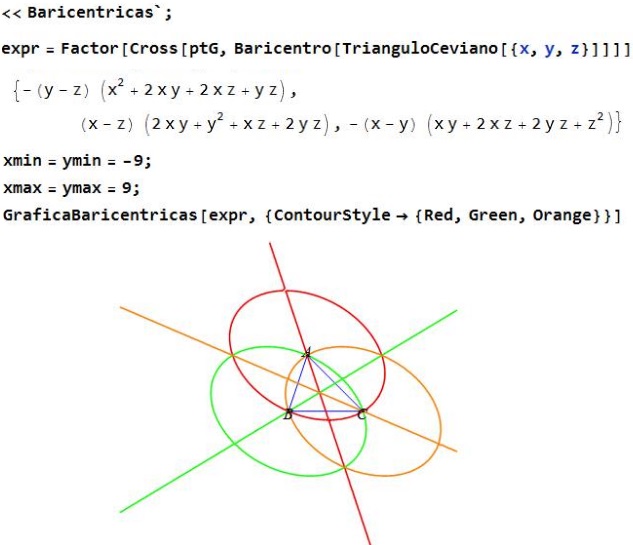Barycenter of Cevian Triangle
Problem

Proof 1
Assume point $P\,$ has barycentric coordinates $P=x:y:z.\,$ This means that the points $D\,$ on $BC,\,$ $E\,$ on $AC,\,$ and $F\,$ on $AB\,$ are defined as $D=0:y:z,\,$ $E=x:0,z,\,$ $F=x:y:0.\,$ If normalized, they appear as
$\displaystyle D=\left(0,\frac{y}{y+z},\frac{z}{y+z}\right),\,E=\left(\frac{x}{x+z},0,\frac{z}{x+z}\right),\,F=\left(\frac{x}{x+y},\frac{y}{x+y},0\right).$
The barycenters of triangles $ABC\,$ and $DEF\,$ are, respectively,
$\displaystyle\begin{align} G &= \left(\frac{1}{3},\frac{1}{3},\frac{1}{3}\right)\\ &= \left(\frac{1}{3}\left(\frac{x}{x+z}+\frac{x}{x+y}\right),\frac{1}{3}\left(\frac{y}{x+y}+\frac{y}{y+z}\right),\frac{1}{3}\left(\frac{z}{x+z}+\frac{z}{y+z}\right)\right), \end{align}$
yielding three equations:
$\displaystyle\frac{x}{x+z}+\frac{x}{x+y}=1,\,\frac{y}{x+y}+\frac{y}{y+z}=1,\,\frac{z}{x+z}+\frac{z}{y+z}=1.$
The first one reduces to $x^2=yz,\,$ the other two to $y^2=xz\,$ and $z^2=xy,\,$ respectively. From these, $x=y=z,\,$ meaning that $P\,$ is the barycenter of $\Delta ABC.$
Proof 2
Taking any point $O\,$ as the origin, we have $OD=\lambda OB+(1-\lambda)OC,\,$ $OE=\mu OC+(1-\mu)OA,\,$ $OF=\nu OA+(1-\nu)OB,\,$ for some $\lambda,\,$, $\mu,\,$ $\nu,$ between $0\,$ and $1.\;$ If in addition the two triangles $ABC\,$ and $DEF\,$ have the same centroid, we must have $OA+OB+OC = OD+OE+OF,\;$ whence $(\nu-\mu)OA+(\lambda-\nu)OB+(\mu-\lambda)OC = 0.\;$ This is true even if $O\,$ is off the plane of $ABC,\,$ in which case $OA,\,$ $OB\,$ and $OC\,$ are linearly independent; so $\lambda=\mu=\nu.\,$ But by Ceva's theorem, $\displaystyle\frac{\lambda}{1-\lambda}\cdot\frac{\mu}{1-\mu}\cdot\frac{\nu}{1-\nu} = 1.\,$ These are only possible if $\displaystyle\lambda=\mu=\nu=\frac{1}{2}.\,$ i.e. if $D,\,$ $E,\,$ $F\,$ are the midpoints of the sides and the three Cevians are the medians of the triangle.
Proof 3
Here is a picture as locus. We calculate the cross product of $G\,$ and the centroid of cevian triangle of $P,\,$ then we get two loci whose intersections are $G\,$ and the vertices of the anticomplementary triangle.

Note that only $G\,$ has a cevian triangle with ordinary (not infinite) points.
Corollaries
For all cevian triangles (except for the medial one), if their centroid coincides with that of $\Delta ABC,\,$ the latter is necessarily equilateral.
Intouch triangle
The intouch triangle is the cevian triangle of Gergonne's point, $Ge=(s-b)(s-c):(s-c)(s-a):(s-a)(s-b).\,$ It coincides with $G(1,1,1)\,$ only if, say, $(s-b)(s-c)=(s-c)(s-a),\,$ or $a=b,\,$ etc., making $\Delta ABC\,$ equilateral.
This supplies a third proof for Marian Dinca's criterion of equilaterality of $\Delta ABC.$
Incentral triangle
The incentral triangle is the cevian triangle of the incenter $I=a:b:c.\,$ It is immediate that it may coincide with the barycenter $G=1:1:1\,$ only if $\Delta ABC\,$ is equilateral.
Extouch triangle
The extouch triangle is the cevian triangle of the Nagel point $I=s-a:s-b:s-c.\,$ It is immediate that it may coincide with the barycenter $G=1:1:1\,$ only if $\Delta ABC\,$ is equilateral.
Orthic triangle
The orthic triangle is the cevian triangle of the orthocenter $H=(a^2+b^2-c^2)(c^2+a^2-b^2):(b^2+c^2-a^2)(a^2+b^2-c^2): \ldots.\;$ It is immediate that it may coincide with the barycenter $G=1:1:1\,$ only if $\Delta ABC\,$ is equilateral.
Cevian triangle of the symmedian point
The symmedian point $K\,$ has the barycentric coordinates $K=a^2:b^2:c^2,\,$ with the obvious conclusion that it coincides with the barycenter $G=1:1:1\,$ only if $\Delta ABC\,$ is equilateral.
Cevian triangle of the circumcenter
The circumcenter $O\,$ has the barycentric coordinates $K=a^2(b^2+c^2-a^2): b^2(c^2+a^2-b^2):c^2(a^2+b^2-c^2).\;$ It's a little more involved than for other points but is not too difficult to prove that it coincides with the barycenter $G=1:1:1\,$ only if $\Delta ABC\,$ is equilateral.
Acknowledgment
The statement has been inspired by Marian Dinca's criterion of equilaterality of $\Delta ABC.$ Proof 2 is by Angelos Tsirimokos; Proof 3 is by Francisco Javier García Capitán.
Barycenter and Barycentric Coordinates
- 3D Quadrilateral - a Coffin Problem
- Barycentric Coordinates
- Barycentric Coordinates: a Tool
- Barycentric Coordinates and Geometric Probability
- Ceva's Theorem
- Determinants, Area, and Barycentric Coordinates
- Maxwell Theorem via the Center of Gravity
- Bimedians in a Quadrilateral
- Simultaneous Generalization of the Theorems of Ceva and Menelaus
- Three glasses puzzle
- Van Obel Theorem and Barycentric Coordinates
- 1961 IMO, Problem 4. An exercise in barycentric coordinates
- Centroids in Polygon
- Center of Gravity and Motion of Material Points
- Isotomic Reciprocity
- An Affine Property of Barycenter
- Problem in Direct Similarity
- Circles in Barycentric Coordinates
- Barycenter of Cevian Triangle
- Concurrent Chords in a Circle, Equally Inclined
|Contact| |Front page| |Contents| |Geometry| |Generalization|
Copyright © 1996-2018 Alexander Bogomolny73554512
